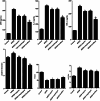Effects of different antiplatelet therapy drugs on platelet activation and platelet-leukocyte aggregate formation in early septic ARDS
- PMID: 39762913
- PMCID: PMC11705853
- DOI: 10.1186/s40360-024-00806-x
Effects of different antiplatelet therapy drugs on platelet activation and platelet-leukocyte aggregate formation in early septic ARDS
Abstract
Background: In patients with sepsis, platelets are activated and adhere to neutrophils, forming platelet-leukocyte aggregates (PLAs) that lead to the development of MODS. ARDS is one of the main manifestations of septic MODS. We designed this study to explore the effects of different anti-plate therapy drugs on platelet activation and platelet-leukocyte aggregate (PLA) formation in the early stage of septic ARDS.
Methods: Sixty adult male SD rats were randomly divided into: Control group; ARDS group, ARDS + aspirin group, ARDS + clopidogrel group and ARDS + tirofiban group. ARDS was performed via instill lipopolysaccharide (LPS) intratracheally at a dose of 5 mg/kg. Aspirin or clopidogrel were given by gavage immediately after modeling. Tirofiban were given by intraperitoneal injection immediately after modeling. Rats in every group were euthanized by rapid decapitation 6 h after modeling. Platelet activation and PLA were assessed using flow cytometry and immunofluorescence staining. Histology of lung was performed by hematoxylin and eosin staining.
Results: Aspirin, clopidogrel and tirofiban decreased CRP, IL-1 and TNF-α significantly in septic ARDS (P < 0.05). Aspirin, clopidogrel and tirofiban decreased platelet function and ratio of wet/dry significantly in septic ARDS (P < 0.05). Aspirin, clopidogrel and tirofiban increased PaO2 significantly in septic ARDS (P < 0.05). Platelet activation and PLA in the ARDS + aspirin group, ARDS + clopidogrel group and ARDS + tirofiban group decreased significantly compared to the ARDS group (P < 0.05). At 6 h after ARDS operation, obvious histological damage was observed in the lungs. All of these histological changes were quantitatively evaluated using injury scores. Aspirin, clopidogrel and tirofiban reduced the histological damages in ARDS group (P < 0.05).
Conclusions: Aspirin, clopidogrel and tirofiban alleviated the inflammatory response and pulmonary edema, reduced platelet function, and alleviated hypoxemia in early septic ARDS. Aspirin, clopidogrel and tirofiban reduced platelet activation and PLA formation in early septic ARDS. Aspirin, clopidogrel and tirofiban ultimately alleviated lung injury in early septic ARDS.
Keywords: ARDS; Aspirin; Clopidogrel; Platelet-leukocyte aggregate; Sepsis; Tirofiban.
© 2024. The Author(s).
Conflict of interest statement
Declarations. Ethics approval: This study was approved by the Institutional Animal Care and Use Committee (IACUC) at Peking Union Medical College, Beijing, China. (IACUC protocol number: XHDW-2023-029). Consent for publication: All authors have agreed to publish it. Competing interests: The authors declare no competing interests.
Figures




Similar articles
-
Comparison of the effects of pretreatment with tirofiban, clopidogrel or both on the inhibition of platelet aggregation and activation in patients with acute coronary syndromes.J Thromb Thrombolysis. 2009 Jan;27(1):36-43. doi: 10.1007/s11239-007-0174-x. Epub 2007 Nov 30. J Thromb Thrombolysis. 2009. PMID: 18049795 Clinical Trial.
-
Effect of clopidogrel treatment on stress-induced platelet activation and myocardial ischemia in aspirin-treated patients with stable coronary artery disease.Thromb Haemost. 2007 Dec;98(6):1316-22. doi: 10.1160/th07-05-0323. Thromb Haemost. 2007. PMID: 18064330 Clinical Trial.
-
Clopidogrel but not aspirin reduces P-selectin expression and formation of platelet-leukocyte aggregates in patients with atherosclerotic vascular disease.Clin Pharmacol Ther. 2003 Mar;73(3):232-41. doi: 10.1067/mcp.2003.13. Clin Pharmacol Ther. 2003. PMID: 12621388
-
Aspirin and clopidogrel resistance: possible mechanisms and clinical relevance. Part I: Concept of resistance.Ideggyogy Sz. 2012 Nov 30;65(11-12):377-85. Ideggyogy Sz. 2012. PMID: 23289172 Review.
-
Value of antiplatelet therapy in preventing thrombotic events in generalized vascular disease.Clin Cardiol. 2000 Nov;23 Suppl 6(Suppl 6):VI-18-22. doi: 10.1002/clc.4960231106. Clin Cardiol. 2000. PMID: 11129682 Free PMC article. Review.
References
-
- Gawaz M, Dickfeld T, Bogner C, Fateh-Moghadam S, Neumann FJ. Platelet function in septic multiple organ dysfunction syndrome. Intensive Care Med. 1997;23(4):379– 85. 10.1007/s001340050344. - PubMed
-
- Chen Z, Liu C, Jiang Y, Liu H, Shao L, Zhang K, Cheng D, Zhou Y, Chong W. HDAC inhibitor attenuated NETs formation induced by activated platelets in Vitro, partially through downregulating platelet secretion. Shock. 2020;54(3):321–9. 10.1097/SHK.0000000000001518. - PubMed
MeSH terms
Substances
Grants and funding
LinkOut - more resources
Full Text Sources
Medical
Research Materials
Miscellaneous

